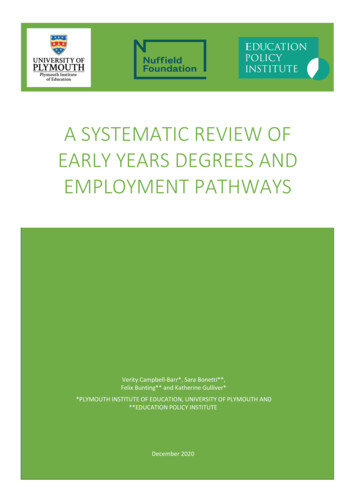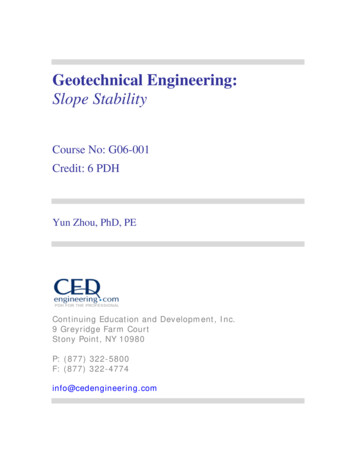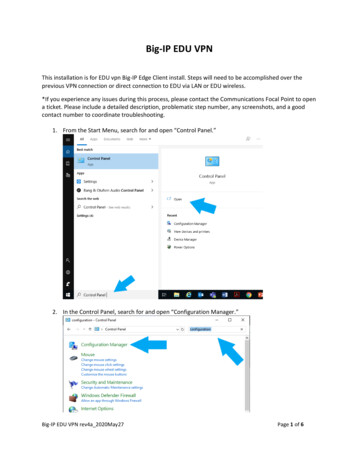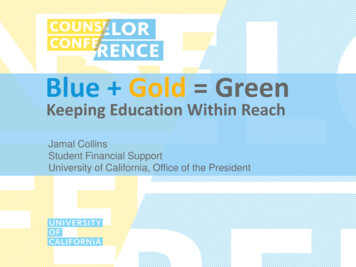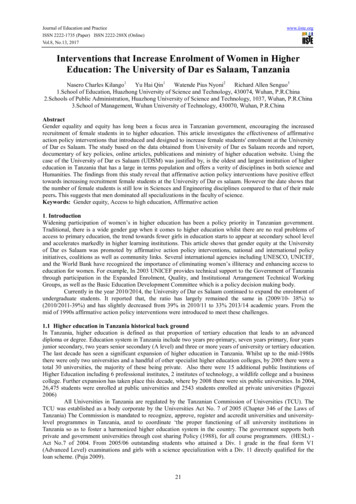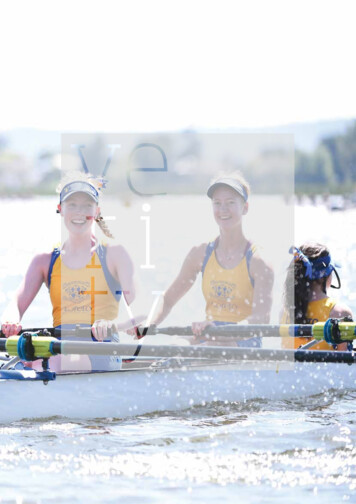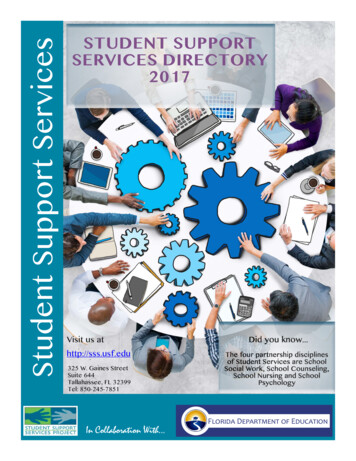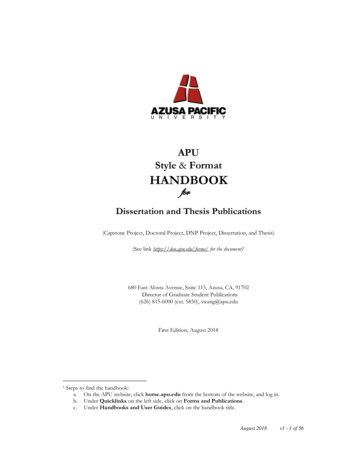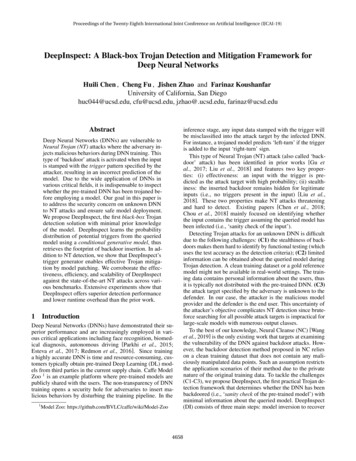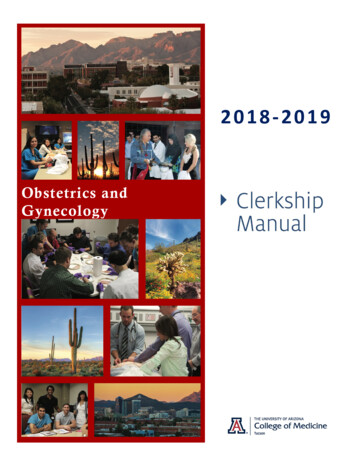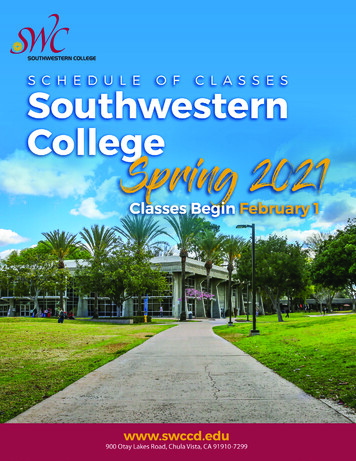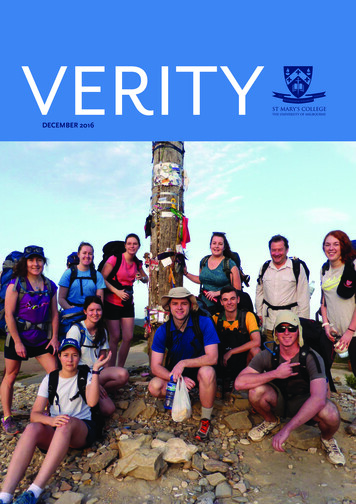
Transcription
VERITYDECEMBER 2016
INSIDE THIS ISSUE03A word from the Principal04From the Editor05Student Club News06A word from the Dean andDeputy Principal09Academic Centre10Reflection from Dr Ian McDonald11Faculty Dinner12College Ball14Camino Pilgrimage16Valete19Sports & Art Dinner20College Musical22Culture Report24Sports Report26Alumni NewsFront cover: The St Mary’s pilgrimagegroup at Cruz de Ferro (Cross of Iron)on the summit of Monte Irago, Spain.Back cover: Onward four of theSt Mary’s pilgrims crossing a streamon their journey towards Santiago deCompostella.2VERITY December 2016
A WORDFROM THEPRINCIPALDR DARCY MCCORMACKIt is hard to believe that we are nearthe end of 2016. It has been a year ofsignificant efforts and achievementsby many; it has been characterisedthroughout by a spirit of generosity,enthusiasm and optimism that augurs wellfor the future.This has also been a year in which thecollege has experienced significant loss:we learned with great sadness of theserious illness and then the death of MsAngela Gehrig, Director of the Allan andMaria Myers Academic Centre. Angela wasmuch loved by everyone at St Mary’s andher smiling, enthusiastic and generouspresence is deeply missed. May she restin peace.There have been some changes in the waythat college operates. For the first time,students were able to stay in college duringthe mid-year break in July – this proved tobe popular and will become a permanentfeature of St Mary’s. Also, for the first time,a group of second year students went onpilgrimage to Spain to walk nearly 300kilometres along the renowned Caminode Santiago de Compostella. The Caminoproved to be challenging physically andpsychologically but, at its heart, this wasa spiritual journey and it delivered inabundance. It had a profound effect on thestudents and myself and I intend makingthis a regular part of college life.STMARYS.UNIMELB.EDU.AUI have been encouraged throughout theyear by the care our students display forone another and for those less fortunatethan themselves – this care is genuine,sensitive, and real. It is based on arecognition that each of us faces our ownchallenges and that there is much that wecan do to support each other, even whenwe do not face that particular challenge.The annual alumni cocktail party wasenjoyed by over 80 people in October - thecold and wet day did not deter attendance!Particularly encouraging was the numberof young alumni attending for the firsttime. The annual alumni Mass the next daywas followed by afternoon tea in the LoretoRoom. I am also grateful for the efforts ofthe alumni working group to plan eventsfor the college’s alumni.The students recently elected their newGeneral Committee (GC) for 2017. As acollege community we thanked the 2016GC, led so effectively by Lucy Joel, for theirsignificant contributions to college life andwelcomed the new president, Dale Beeton,into the role.Over the last few days I have farewelledindividually several students leavingcollege. Without exception they haveexpressed deep gratitude for their timehere, and for the opportunities and thesupport they have received during yearsof significant transition in their lives, inaddition to their academic studies. I haveno doubt they realise how fortunate theyhave been to experience life in this collegecommunity!I wish to acknowledge here the notableachievement, and ongoing significantcontributions, of Dr Ian McDonald,who for 25 years has been the college’schemistry tutor. Ian’s wisdom and readywillingness to help students and staff alikeis an inspiration to us all!The college approaches its centenary in2018 with confidence. Although societyhas evolved and changed significantly,the vision of the Loreto Sisters whoestablished St Mary’s Hall nearly 100 yearsago remains as relevant and importanttoday as it was then. We hope to celebratethis significant milestone appropriately.Finally, I am delighted to welcome Verity’snew editor, Mrs Brenda Renfrew. Brendabrings a deep appreciation of the college’sethos and vast experience in Catholiceducation. She has settled well into herrole as the college secretary.I wish you all a Christmas that is richlyblessed with family and friends, and allthat really matters!Dr Darcy McCormackPrincipal3
FROMTHE EDITORAs a new member of the St Mary’sCollege community, I would firstly like tothank the staff and many students whohave warmly welcomed me to what isclearly ‘home away from home’. From allaccounts, Semester 2 has run smoothlyand the various events held throughoutthis time have been celebrated in true StMary’s spirit.The pages to follow provide an insightto the past few months in college.Among the content is a reflection byDr Ian McDonald on his 25 years asthe college’s chemistry tutor; a movingtribute to the late Ms Angela Gehrig,Director of the Allan and Maria MyersAcademic Centre, who died at theend of the semester; an account ofthe Camino de Santiago pilgrimagein Spain undertaken by a group of tensecond year students and the principal,Dr Darcy McCormack, in July; a reporton an Academic Dinner with collegealumnus, Dr Tim Moore of the Facultyof Business and Economics; and reportson several activities by the student club.4Mary Ward encouraged her followers totake risks and to forge new paths, butto be wise and discerning in the choicesthey made. By ‘referring all things toGod’ they would recognise where theneeds were greatest. As we move intothe Christmas season, may we beinspired by her words and while weenjoy the festivities, be mindful of takingcare of each other.Best wishes for a new year full ofwonderful surprises!Brenda RenfrewVERITY December 2016
STUDENTCLUB NEWSSemester 2 saw acontinuation of thefantastic start to theyear. Formal dinnerswere well attended andeveryone enjoyed takingthe time to acknowledgeand appreciate theachievements of thecollege community.At the Christmas in July dinner held in thefirst week back, both the Principal and Ireflected on how college has become ade facto family for many and the studentclub took the chance to thank the collegestaff for all they contribute to creatingthat warm and welcoming environmentwe love so much. This continued with theDean’s dinner the following week wherewe recognised the substantial academicachievements many of our students hadmade the prior semester.Guardian Angel week allowed us to relievethe ever mounting stress and surprise ourallocated ‘mortal’ with chocolate, coffeeor other sweet gestures. It is always anice way to break up the semester and itgives students the opportunity to try anddiscover a little bit more about someonethey may not know too well in an effort tosurprise them with something they willreally appreciate.STMARYS.UNIMELB.EDU.AUThe college production of Legally Blonde theMusical and the oratory competition wereboth highly entertaining and allowed us seesome of the other talents that our studentshave been hiding.It has been a highly enjoyable year andI am incredibly proud of what has beenachieved by both my peers, and thestudent club. It has now been 50 yearssince the incorporation of the student cluband in that time we have worked hard toestablish a community of hard working,socially minded individuals who try toembody the college motto of beingseekers of truth and doers of justice.The friendships and the memories wehave created here will stay with us for lifeand I will always be incredibly glad to havecalled St Mary’s home.Lucy Joel2016 President5
A WORD FROMTHE DEANAND DEPUTYPRINCIPALMS RACHEL LECHMEREExcerpt from Dean’s DinnerSpeech, August 2016To begin, I would like to acknowledge theWurrundjeri People, the Traditional Ownersof the land on which we are gathered andpay my respects to their Elders both past andpresent. I would also like to acknowledgepast and present Australian Loreto Sisters,the order of Catholic Religious Sisters whofounded St Mary’s in 1918 and who led thisCollege until 2013. We are the recipientsof their original vision, hard work andcommitment to quality education.The purpose of our gathering tonight is torecognise students who achieved highly intheir studies last semester. In an academicsetting such as ours here at St Mary’s, wevalue high academic achievement and theeffort that it involves.Some of the greatest stories of humanachievement come from the pursuit ofsporting and athletic excellence, and nonemore so than those that arise from theOlympic Games. For hundreds of yearshuman beings have sought to challengebody and mind, probing the limits ofhuman performance, breaking the records(and the occasional leg) of those who havegone before. Already, amidst all the dramaand colour of Rio in the past four days wehave heard and seen extraordinary talesof success.6How can you not but admire the goodhearted banter and competitiveness ofCate and Bronte Campbell, sisters whoare strong and determined in the pool andin life, but whose love for their brotherHamish, as they describe, outshines all oftheir achievements? Hamish has cerebralpalsy and is confined to a wheelchair.Bronte explains: “he can’t do anything forhimself, yet he’s the happiest kid in theworld. You don’t really have the right to beupset about a swim race when your littlebrother can’t feed himself, talk or speak”.They are down to earth, humble, smart andauthentic women. Their achievements areall the more inspiring for this in my view,because they have not forgotten about whatreally matters, despite their extraordinaryaccomplishments.So too of the first ever Refugee OlympicTeam, surely one of the best feel-goodstories from the Olympics so far. Why do Ifind this story inspiring? Perhaps becauseagainst the background of the breakdownin peace and harmony in the many partsof our world, the human spirit and globalcooperation have restored the hopes ofthese athletes. The vision of the modernOlympics, namely to promote peace andbuild bridges between nations, cultures andpeople, is still every bit as relevant now asin 1894. While each of us enthusiasticallysupport the athletes of our respectivecountries, cheering them on, injected uswith national pride when they have success,the athletes of the refugee team have beenforced to flee the very nations that theywould proudly seek to represent. Of the 43members of the team most were extractedfrom unhappy circumstances in refugeecamps; hardly conditions that wouldnurture an ideal Olympic preparation.You may have followed the story of YusraMardini this week. Yushra is an 18-year-oldswimmer for the refugee team. She swamcompetitively in Syria and she and hersister were considered to be the country’srising stars until they fled their countrywhen the war intensified two years ago.Eventually arriving in Turkey after fleeingDamascus, they paid people to take themto Greece and after several failed attempts,they boarded a small inflatable dinghy juston nightfall. There were 20 people on thedinghy and after half an hour the boat hadstarted to take on water. They threw off all ofthe passenger’s belongings, and eventuallythe only three who people on board whocould swim: Yushra, her sister and oneother, entered the water to give the boatmore buoyancy. They kept the dinghy afloatfor three and a half hours until it reachedan island in Greece. This 18-year-oldwoman metaphorically swam her way to theOlympics, and saved 17 other lives in theprocess. According to the UNHCR, nearly50 percent of the refugee population wasunder 18 years old as of 2013. Fifty percentVERITY December 2016
Image courtesy of Googleof the world refugees are younger thanmost of you. It’s hard not to be inspired byYushra and the vision of those who broughtthe Refugee Olympic team into being.A less well known story of inspirationemanating from the Olympics greets usevery time we enter and move around thisdining room and has done so for years.Have you ever wondered about this phototo my left on the wall? What moment doesit capture? What sport is it? What year? Whoare the individuals? Where are they from?What badges and medals are they wearing?What is their story?This picture was given to Sr Liz Hepburnwhen she was Principal of St Mary’s in2012. It was given to her by our longserving, highly respected and semiresidential Chemistry tutor, Ian McDonald.He’s the one with the long hair andglasses that you see here on Tuesdayand sometimes Thursday nights. Ian isin his 25th year of tutoring here and hashelped decades of St Mary’s studentsperform to their best in Chemistry. Inaddition to having a PhD in Chemistry,Ian works full time for the organisationAustralian Volunteers International as theRecruitment Manager, facilitating highlyskilled Australians to go overseas and workon development projects that will have alasting positive impact on others. He sayshe does this work “because he had theprivilege of being an Australian Volunteer(chemistry teacher) in the Solomon Islands30 years ago and it was an extraordinary lifechanging and career defining experience”.He “believes every Australian should havethe opportunity to have such an experienceshould they wish because bringing peopletogether of different cultures – living,working and learning alongside of eachother is simple recipe to making the world abetter and fairer place for all.”So what is the photo? It is a very iconicimage. It was taken at the medal ceremonyof the 1968 Olympics in Mexico City for theMen’s 200 metres athletics final. It showstwo African Americans, John Carlos andTommie Smith with their bowed headslistening to the US National Anthem“Star Spangled’ banner, being played.Most notable is their rebellious raisingto the air of their black-gloved fists,STMARYS.UNIMELB.EDU.AUPhoto hanging in the St Mary’s Dining Room.Inscription below the photograph hanging in the St Mary’s Dining Room.a gesture in support of African Americancivil rights in the very year that MartinLuther King was assassinated. You cansee it in the photo, but they received theirmedals barefoot, to represent the povertyfacing people of colour. The action takenin support of human rights by these twomen was courageously in defiance of theOlympic charter which stated that ‘no kindof demonstration or political, religiousor racial propaganda is permitted in theOlympic areas’. As Riccardo Gazziniga tellsit “the head of the American delegationvowed that they would pay for this defiancefor their entire lives; they were immediatelysuspended from the American OlympicTeam and expelled from the Olympicvillage once home, the two fastest menin the world faced heavy repercussions anddeath threats”. Of course, the passing oftime has validated their actions, and theirreputations have been restored to a placeof national pride, where they should alwayshave been.Yet, the story of the third, white man inthe photograph is less well known. Thisis Peter Norman, an Australian man, who7
won silver in the same race. Norman knewthat something was about to happen beforethe medal presentation, for the word hadspread amongst the athletes that Carlosand Smith were going to use this momentfor a gesture of solidarity and activism.Norman was sensitive to the injusticesthat Aboriginal people in Australia faced.Gazziniga continues:“The two Americans had asked Normanif he believed in human rights. Normansaid he did. They asked him if he believedin God, and he said he believed stronglyin God. Of this moment John Carlos, thebronze medallist remembers, “we knewthat what we were going to do was fargreater than any athletic feat, and he said“I’ll stand with you”. I expected to see fearin Norman’s eyes, but instead we sawlove.” Norman said “I believe in what youbelieve.” He then asked to wear the sameOlympic Project for Human Rights badgethat the others were wearing on their chestssaying “that way I can show my support foryour cause.”The three went out on the field and got upon the podium: the rest is history, preservedin the power of the photo. “I couldn’t seewhat was happening,” Norman recounts,“[but] I had known they had gone throughwith their plans when a voice in the crowdsang the American anthem but then fadedto nothing. The stadium went quiet.”Peter Norman still holds the Australianrecord for the Men’s 200m, 47 yearslater. But he was punished for standingin solidarity with Carlos and Smith, andhe suffered alone, without the supportof the broad movement for change thatthe Americans had. In the Olympics thatfollowed four years later, Norman was notchosen for the Australian team, despitequalifying thirteen times. He was forcedto leave competitive athletics behind.He was treated like and outsider and hisfamily outcast. Disappointments take theirtoll, and Norman endured many personalproblems as a result. He was told hecould receive a pardon and perhaps find astable job on the Olympics Committee butonly if he condemned Carlos and Smith’sgesture. He refused to do this, and nevercondemned them or their choice. Whenthe Sydney Olympics were held in 2000.8Norman, the fastest Australian sprinter inhistory was not invited. When he died 10years ago, the two men beside him in thatphot, were his pallbearers. They said of him“Peter was a lone soldier, he consciouslychose to be a sacrificial lamb in the nameof human rights. He paid the price withhis choice. It wasn’t just a simple gestureto help us, it was His fight. He was a whiteman among two men of colour, standing upin the moment of victory, all in the name ofthe same thing. There is no one more thanhim that Australia should honour, recogniseand appreciate.”Only four years ago in 2012 did theAustralian Parliament acknowledge andapologise to him, recognising his braveryand the ‘powerful role that Peter Normanplayed in furthering racial equality’.In recounting the event years before hisearly death, Peter himself said:“I couldn’t see why a black man couldn’tdrink the same water from a water fountain,take the same bus or go to the same schoolas a white man. There was a social injusticethat I couldn’t do anything about fromwhere I was, but I certainly hated it. It hasbeen said that sharing my silver medal withthat incident on the victory dais detractedfrom my performance. On the contrary. Ihave to confess; I was rather proud to bepart of it”.behind it, and that it will inspire you to beyour best, knowing that nothing of truevalue comes without a cost.In each of the stories just told, what isremarkable is the way the each of themhave used their talents to promote humandignity and elevates our entire globalcommunity to strive for what is good andjust. It is personal achievement that servesothers, with humility and an open heart.And so too it is hoped, for our awardwinners tonight. We acknowledge youreffort and the commitment that has ledyou to achieve so highly. In the samemanner that our country feels proud of andcelebrates its medal winners, we celebratewith you too, and may it compel each ofus to strive for our best in all that we do,in study and in life, and to always stand upand speak out for what is right and good.Our intellectual achievement is not ameasure of our intrinsic human worth. Yetliving in this academic environment as wedo, we recognise and celebrate those amongus who make the most of what they havebeen given, in both achievement and effort.Ms Rachel LechmereThe Dean and Deputy PrincipalThe inscription from Ian on the bottomof our photo frame says:“To Sr Liz and the staff of St Mary’sCollege. In recognition of your inspiringcommitment to the Mary Ward tradition ofjustice for all people.”I expect that those who chose to hangit in the dining room, the heartbeat ofour college, did so quite intentionally.The Catholic faith traditions of St Mary’sare built on the foundations of activismand social justice. For the Loreto sisters,coming to St Mary’s to live while you get agood education is worthwhile to the extentthat the individual can give back to thecommunity in greater measure and makeit more just. Each time you walk into thedining room and your eyes land upon thisphoto, I hope you will see the extraordinaryrespect for dignity and justice that lieVERITY
Finally, I am delighted to welcome Verity’s new editor, Mrs Brenda Renfrew. Brenda brings a deep appreciation of the college’s ethos and vast experience in Catholic education. She has settled well into her role as the college secretary. I wish you all a Christmas that is richly bles
